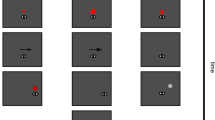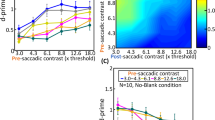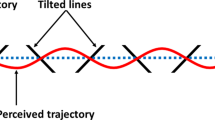Abstract
A central problem in human vision is to explain how the visual world remains stable despite the continual displacements of the retinal image produced by rapid saccadic movements of the eyes. Perceived stability has been attributed to ‘efferent-copy’ signals, representing the saccadic motor commands, that cancel the effects of saccade-related retinal displacements1,2,3,4,5,6. Here we show, by means of a perceptual illusion, that traditional cancellation theories cannot explain stability. The perceptual illusion was produced by first inducing adaptive changes in saccadic gain (ratio of saccade size to target eccentricity). Following adaptation, subjects experienced an illusory mislocalization in which widely separated targets flashed before and after saccades appeared to be in the same place. The illusion shows that the perceptual system did not takethe adaptive changes into account. Perceptual localization is based on signals representing the size of the initially-intended saccade, not the size of the saccade that is ultimately executed. Signals representing intended saccades initiate a visual comparison process used to maintain perceptual stability across saccades and to generate the oculomotor error signals that ensure saccadic accuracy.
This is a preview of subscription content, access via your institution
Access options
Subscribe to this journal
Receive 51 print issues and online access
$199.00 per year
only $3.90 per issue
Buy this article
- Purchase on Springer Link
- Instant access to full article PDF
Prices may be subject to local taxes which are calculated during checkout



Similar content being viewed by others
References
von Helmholtz, H. Treatise on Physiological Optics vol. 3 (1910) (trans. Southall, J. P. C.) (Dover, New York, 1963).
von Holst, E. & Mittelstaedt, H. Das Reafferenzprinzip. Naturwissenschaften 37, 464–476 (1950).
MacKay, D. M. in Handbook of Sensory Physiology vol. VII/3: Central Processing of Visual Information (ed. Jung, R.) 307–331 (Springer, Berlin, 1973).
Matin, L. in Handbook of Sensory Physiologyvol. VII/4: Visual Psychophysics (eds Jameson, D. & Hurvich, L. M.) 331–380 (Springer, Berlin, 1972).
Skavenski, A. A., Haddad, G. M. & Steinman, R. M. The extraretinal signal for the visual perception of direction. Percept. Psychophys. 11, 287–290 (1972).
Skavenski, A. A. in Eye Movements and Their Role in Visual and Cognitice Processes (ed. Kowler, E.) 263–287 (Elsevier, Amsterdam, 1990).
McLaughlin, S. C. Parametric adjustment in saccadic eye movement. Percept. Psychophys. 2, 359–362 (1967).
Deubel, H. Separate adaptive mechanisms for the control of reactive and volitional saccadic eye movements. Vision Res. 35, 3529–3540 (1995).
Miller, J. M., Anstis, T. & Templeton, W. B. Saccadic plasticity: parametric adaptive control by retinal feedback. J. Exp. Psychol. Hum. Percept. Perform. 7, 356–366 (1981).
Erkelens, C. J. & Hulleman, J. Selective adaptation of internally triggered saccades made to visual targets. Exp. Brain Res. 93, 157–164 (1993).
Carpenter, R. H. S. Movements of the Eyes2nd edn (Pion Press, 1992).
Kowler, E. & Blaser, E. The accuracy and precision of saccades to small and large targets. Vision Res. 35, 1741–1754 (1995).
Matin, L. & Pearce, D. G. Visual perception of direction for stimuli flashed during voluntary saccadic eye movement. Science 165, 1485–1488 (1965).
Lennie, P. & Sidwell, A. Saccadic eye movements and visual stability. Nature 275, 766–768 (1978).
Dassonville, P., Schlag, J. & Schlag-Rey, M. Oculomotor localization relies of a damped representation of saccadic eye displacement in human and nonhuman primates. Vis. Neurosci. 9, 261–269 (1992).
Sperling, G. in Eye Movements and Their Role in Visual and Cognitive Processes (ed. Kowler, E.) 307–351 (Elsevier, Amsterdam, 1990).
Goodale, M. A., Pelisson, D. & Prablanc, C. Large adjustments in visually guided reaching do not depend on vision of the hand or perception of target displacement. Nature 320, 748–750 (1986).
Deubel, H., Schneider, W. X. & Bridgeman, B. Postsaccadic target blanking prevents saccadic suppression of image displacement. Vision Res. 36, 985–996 (1996).
Ludvigh, E. Control of ocular movements and visual interpretation of environment. AMA Arch. Ophthalmol. 48, 442–448 (1952).
Pola, J. in Eye Movements and Psychological Processes (eds Monty, R. A. & Senders, J. W.) 245–254 (Erlbaum, Hillsdale, New Jersey, 1976).
Andersen, R. A., Essick, G. K. & Siegel, R. M. Encoding spatial location by posterior parietal neurons. Science 230, 456–458 (1985).
Duhamel, J.-R., Colby, C. L. & Goldberg, M. E. The updating of the representation of visual space in parietal cortex by intended eye movements. Science 255, 90–92 (1992).
Optican, L. M. in Adaptive Mechanisms in Gaze Control (eds Berthoz, A. & Melvill-Jones, G.) 71–79 (Elsevier, Amsterdam, 1985).
Goldberg, M. E., Musil, S. Y., Fitzgibbon, E. J., Smith, M. & Olson, C. R. in Role of the Cerebellum and Basal Ganglia in Voluntary Movements (eds Mano, M., Hamada, I. & DeLong, M. R.) 203–211 (Elsevier, Amsterdam, 1993).
Frens, M. A. & Van Opstal, A. J. Monkey superior colliculus activity during short-term saccadic adaptation. Brain Res. Bull. 43, 473–483 (1997).
Desmurget, M. et al. Functional anatomy of saccadic adaptation in humans. Nature Neurosci. 1, 524–528 (1998).
Crane, H. D. & Steele, C. S. Accurate three-dimensional eyetracker. Appl. Opt. 17, 691–705 (1978).
McGowan, J., Kowler, E., Sharma, A. & Chubb, C. Saccadic localization of random dot patterns. Vision Res. 38, 895–909 (1998).
Cornsweet, T. The staircase method in psychophysics. Am. J. Psychol. 75, 485–491 (1962).
Leigh, R. J. & Zee, D. S. The Neurobiology of Eye Movements 82 (F. A. Davis, Philadelphia, 1991).
Acknowledgements
Supported by the U.S. Air Force Office of Scientific Research, Life Sciences Directorate, Program on Spatial Orientation. We thank J. Feldman and M. Regan for helpful comments.
Author information
Authors and Affiliations
Corresponding author
Rights and permissions
About this article
Cite this article
Bahcall, D., Kowler, E. Illusory shifts in visual direction accompany adaptation of saccadic eye movements. Nature 400, 864–866 (1999). https://doi.org/10.1038/23693
Received:
Accepted:
Issue Date:
DOI: https://doi.org/10.1038/23693
This article is cited by
-
Altered oculomotor flexibility is linked to high autistic traits
Scientific Reports (2023)
-
Adaptive changes to saccade amplitude and target localization do not require pre-saccadic target visibility
Scientific Reports (2023)
-
Vision as oculomotor reward: cognitive contributions to the dynamic control of saccadic eye movements
Cognitive Neurodynamics (2021)
-
Disrupting saccadic updating: visual interference prior to the first saccade elicits spatial errors in the secondary saccade in a double-step task
Experimental Brain Research (2015)
-
Updating of Visual Space Across Horizontal Saccades in Cerebellar and Thalamic Lesion Patients
The Cerebellum (2013)
Comments
By submitting a comment you agree to abide by our Terms and Community Guidelines. If you find something abusive or that does not comply with our terms or guidelines please flag it as inappropriate.



